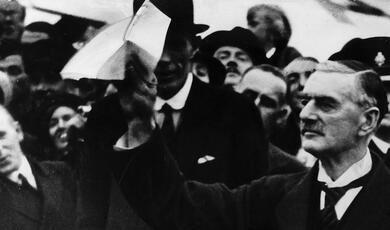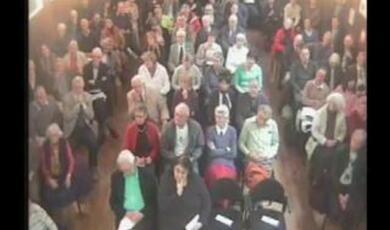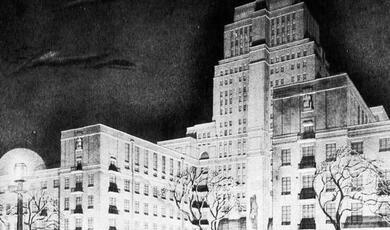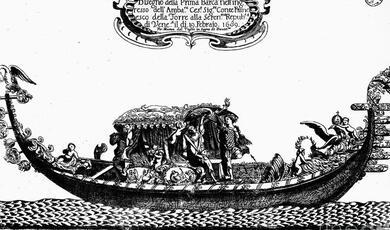Inside Story
Share
- Details
- Text
- Audio
- Downloads
- Extra Reading
In this lecture Professor Hellawell introduces his own work Inside Story, premiered at the 1999 Proms to wide acclaim. The composer gives a background talk to the shape of the work, which pairs violin and viola solists with orchestra in the manner of Mozart's Sinfonia Concertante. He outlines his close collaboration with its soloists and guides the listener through recorded examples from the work.
Download Text
Professor Piers Hellawell
[in the live presentation the soloists Clio Gould (violin) and Philip Dukes (viola) were involved in parts of the discussion, and were invited to perform the extended Recitative that opens movement II]
EX Inside Story - (i) middle section
Background
This series has been concerned so far with various aspects - philosophical, historical and sociological - of the shifting relationship between new music and its audience. None of this, however, is the issue itself, but merely the circumstance that surrounds the issue, namely the encounter between new art and the listener who reacts to it.
It makes sense, therefore, to carry the implication through to presentation of actual work, so as to make that encounter real. My excuse for presenting my own music is that I can be a more reliable guide to this than to any other repertoire.
This, therefore, is an introduction to my most recent large-scale piece, a double concerto for violin and viola soloists and orchestra called Inside Story. It was written for the 1999 Prom Concerts, where my guests today, Clio Gould and Philip Dukes, premiered it to great acclaim. It is my very great pleasure to be welcoming these friends and colleagues to Gresham College.
This is particularly appropriate, since these two artists were truly the starting-point for this work. In 1996 I was working with Clio in another context and had the idea of putting her and Philip together in a solo setting. I wrote the work between spring 1998 and spring 1999. The premiere was in August 1999, since when there have been three more performances, two of them with these soloists - and numerous broadcasts. We plan to record the work with the original forces (BBC SSO) in June.
There is a third 'godparent' not present today: conductor Martyn Brabbins was hugely influential in every stage of this piece. He supported the idea at the BBC commission stage, and later gave me much specific advice when inspecting the music in ms. I cannot exaggerate his importance in the genesis of the piece.
Concept
The title indicates not the presence of a hidden agenda, but the lack of one. This work has (unusually for me) no extra-musical associations of any kind: the title indicates that the story here is the music - the internal relationships, contrasts and atmospheres. While this is true of the huge majority of classical works, there is a marked trend today, especially at high-profile events like the Proms, toward pieces that arrive with much non-musical association; while this delights marketing people, I do believe - as you may have heard in my third talk, Will the last listener please turn out the light - that it is less useful to the listener in the hall. As I put it then:
" Audiences faced with the individuation discussed above - the lack of lingua franca - are hungry for the hidden 'back entrance' to the work of art, and will seize upon colourful references to Mayan cave-paintings, suicidal Swiss artists or (in my case) the shamans of the itinerant Sami people. Yet we should distinguish between interest and information: I believe these background stories are more interesting than informative, for their associative relation will do nothing to guide a listener through a piece." (1)
I therefore wanted to distance myself from this trend, of which I am a part, and to deliver a 'piece' - music whose subject-matter consists of what is heard.
Involvement of artists
It is constant in my composing life that all my pieces start with specific performers. I have never in my adult career written an unsolicited piece out of some internal 'inspiration' -though many end up being performed by other artists, after those who instigated them fell by the wayside. I find I have to be able to imagine a projected performance situation. As a result, the input from such artists is an integral ingredient in my process, and on occasions when I am not able to keep in touch with a contact person along the way, the writing is that much more of a struggle.
I am immediately seized with doubts about motivation - 'What is the point? Who really wants this piece?' and so on. On the other hand, this collaborative process is limited, for while the composer writes the performer is perforce elsewhere, both in professional terms and literally: given the pressure players face earning a daily income at UK fee levels, they are likely to have the head down worrying about this week's music, not next year's. The composer is, really, still alone, but the intermittent contact is invaluable.
Inside Story was of necessity a collaborative effort. For me and for Clio it was a first time at the Proms, and we all wanted to get it right. The soloists had their proper concerns about the solo parts, the conductor about balance problems (especially in that stadium) and I about anything and everything. As a result, there were scraps of solo part being faxed and mailed regularly, while conductor and I had some lively exchanges as the score appeared. After the sending of pages came the phone consultations; the two soloists reacted very differently to what I sent them. Clio never asked me to change anything, invariably offering her imprimata to whatever I wrote ('very high' is the only judgement I remember). Phil, on the other hand, gave many hours to correcting slurs, so that the solo part would be player-friendly. This necessitated many laborious phone conversations, but the result was a feeling that he was really shaping - and hence, I hope, gaining ownership of-the part.
External Layout
This work has two movements, rather than the three of the mainstream concerto tradition -which has no relevance to my thinking about this work. A two-movement shape is, I realise, a recurring feature of my instrumental work over the last decade.
To be honest, the work that immediately preceded this, a piano quartetThe Building Of Curves (1997-8), has the identical dramatic shape: a fast, toccata-like first movement is followed by a more fragmented slow movement. This was not so much a conscious decision as an unconscious feeling that I wanted to try the same shape on a larger scale: I only became aware of the similarity much later. The 'binary' layout - contrasting structure of two parts - occurs as far back as 1992, within continuous pieces like Memorial Cairns. Usually it is a fast-slow layout.
1 Hellawell, P Will The Last Listener Please Turn Out The Light Gresham College 2000 (for full transcript see www.gresham.ac.uk/music)
Inside Story is the second of a series of double concerti, that is, works for two soloists and orchestra. The violin/viola combination has been made famous by the masterpiece by Mozart, but, following from the plan to combine these two soloists, I was struck that there are actually virtually no such concerti after Mozart, perhaps because of a proper sense of caution that I failed to show. My first concerto in the series had no such problems, being for recorder (Michala Petri) and percussion (Evelyn Glennie) - the only such work to date, so far as I know. The series is to be completed by a work for trumpet and trombone in 2004.
The motivation behind this series was largely artist-driven - having the opportunity to pair certain artists, as already explained - but also arose from a desire to inject a more chamber-music aspect into the display/confrontation aspect of the solo concerto. I do not see my works for solo and orchestra as within the concerto tradition (though others probably will); traditional notions of display and competition play no part in my music, so concertante labels too seem inappropriate. The solo roles, then, have a poetic, rather than a dramatic, function. In my view, in fact, the inside story of many established concertos is more of negotiation than of struggle. The very inbalance between orchestra and soloist ensures a trade-off between power and agility: an agreement to share musical air-space. So something much more collaborative is behind Inside Story - though I do not know whether it feels like that to the soloists!
Musical Introduction
The earlier lecture from which I quoted above concludes that listeners more than ever need pathfinders, for each new work today follows an individual track, in a way not true, for example, of Classical works. I explained how 'individuation' of art has seen the notion of framework removed from modern repertoire - as I put it,
"The work of art has become a restricted area, whose entry is controlled by its own PIN number." (1)
But though having heard piece x last week offers no indication of what you will find in piece y this week, it is all too rare that the cumbersome process of detailed guidance is available. This is one such opportunity.
I mentioned that Inside Story comes in two contrasted parts. The most obvious level of this contrast is fast-slow, yet this is only one of several levels: others concern texture and solo roles, for example. So the first movement is not only fast, but it involves much of the orchestra for much of the time - rather than breaking it down. You heard this in my opening excerpt. The other movement, by contrast, explores various small groups. Then the soloists, who play 'on the surface' of the orchestral texture in movement 1, move in movement 2 to more of a leading or soloistic role - instead of being carried within an orchestra, they are at the forefront of smaller ensemble textures. Finally, movement 1's single span of movement is contrasted by the more halting, sectionalised progress of movement 2.
Movement 1 may be continuous, but it does have internal contours. At each end of the movement, and in the middle, lies material I think of as a refrain - each of these three sections lasts about 1 minute. My opening example was the middle refrain. The opening section presents the refrain's two main ideas, separated by a solo spot that Philip says is the only really difficult writing in his part. The two ideas are a rhythmic pattern and a theme; the rhythm is simply a trochee, a long-short motif, right at the start, and the other is a fragment of theme built around just three notes. Between them comes the brief but difficult duet for violin and viola.
EX 1st movement: Opening
Whereas the opening refrain builds up, the closing one begins as the tutti highpoint, before levelling off into a coda. The trochee motif and the theme are barely disguised in outline.
EX 1st movement: final section
These three pillars leave two large panels between them. These are harder to reduce to simple components, but both are constructed in paragraphs that build toward peaks - like waves of varying stature. The wave analogy applies to the texture of these paragraphs: the earlier phases are chamber-like in texture, but these build to fuller scoring as the movement progresses. This example introduces a theme in rather muted string colours; by the time the wave breaks, it has emerged in the top register.
EX 1st movement: G1 onwards
Any such examples are hard to pluck out of the continuous whole. The second movement, contrasted in the ways explained above, lends itself much more to snapshot illustration, for it is in clear subdivisions. The outline is as follows:
<Recitative - variation sections I-V - Vivo - variation sections Vl-IX - Vivo coda>
The thread of this movement is a series of variation sections, built tightly around a chord sequence. This would be quite straightforward but for a brash interruption, marked vivo, that cuts in between the 5th and 6^ variation - thus pushing the separated variations into two blocks. This fast tempo returns, finally, to provide a coda. This variation set and its coda is preceded by a large recitative section, further complicating the design! I shall return to this later.
The variation materials are the simplest and most traditional possible source: a series of chords - though given in an unusual instrumentation, double-bass harmonics and harp. This can be heard here, first the chords only (on piano) and then the orchestral basses, with the Dukes viola weaving around them and in fact providing the bass beneath the chords.
EX piano chords then 1st variation section
I think about almost everything I write in terms of harmonic result first and last, so it is no surprise that I chose here to work with a basic scaffolding that is primarily a harmonic series. It does also have a simple melodic outline, but the harmonies remain the structural basis, being filled out as the orchestral groupings swell.
For example, the violin entry follows the section we just heard in companionship with a brass ensemble; here the chords have been filled into a chorale. This was actually a tribute to Dvorak's Cello Concerto - the famous passage for solo cello and trombones - or rather a private tribute to my friend Jan Smaczny, whose handbook on that work appeared around the time of this composition.
EX violin and brass variation
The second bunch of variations introduces an unusual solo instrument, the flugelhom, which has a full, mellow tone that I guessed would 'balloon' out in the great wastes of the Albert Hall. It appears, low and then high, in variations vi and viii, with a lush variation for soloists in between. This example includes the central vivo section and the subsequent variations up to the coda.
EX vivo - variations vi to -ix
And so to the recitative that opens the second-movement sequence. I wanted to open with a kind of arioso writing because I was aware that the energetic first movement allowed little chance for the solo instruments to sing; I feel that, regardless of the stylistic language, music for strings that has no singing aspect is attempting something very difficult to bring off. I felt this was an especially pressing issue for the viola, who has to show a clean pair of heels throughout movement 1.
The recitative has a simple shape: viola solo - [duo link] -
violin solo - [duo climax]
after which the string section, who have been accompanying on open strings, lead into the variations. Their final shot is a clamorous arpeggio, first explored at the outset by the soloists, as we shall shortly hear. The sound of all the strings reaching up to the highest reaches of the hall was my first musical image for the work.
EX Recitative section (opening of movement II)
© Piers Hellawell
This event was on Sat, 18 May 2002
Support Gresham
Gresham College has offered an outstanding education to the public free of charge for over 400 years. Today, Gresham College plays an important role in fostering a love of learning and a greater understanding of ourselves and the world around us. Your donation will help to widen our reach and to broaden our audience, allowing more people to benefit from a high-quality education from some of the brightest minds.


 Login
Login







